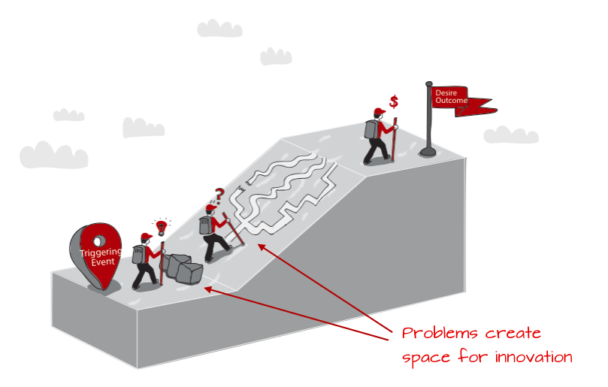When I started this blog, I often spent upwards of 8 hours on a single blog post. Some of my entrepreneur friends and advisers asked how I could afford to take this much time away from my core business. I said it clarified my thinking, plus readership (albeit small) was growing — so it seemed to add some value. But will it scale? Sixteen months later, I turned those blog posts into a best-selling book: Running Lean. I sold my core business and started a new company (LEANSTACK) whose mission is to build better entrepreneurs.
Along the way, I started tinkering with the idea of capturing a business plan on a single page — which led me to the Business Model Canvas — which I further refined into the Lean Canvas. I spent the next several years building and testing an innovation methodology synthesizing business modeling, systems thinking, and lean startup principles through small workshops and bootcamps. But will it scale? Fast forward to today, over a million people use Lean Canvas, and we are starting to enter the scaling phase for LEANSTACK.
We are obsessed with the myth of overnight success, but even hyper-growth companies like Facebook, Airbnb, and Slack all went through the flat part of the hockey-stick curve. More important, as Paul Graham nicely illustrated in this post, doing unscalable things pre-product/market fit is the requisite crank you need to get your engine of growth started and carry yourself to post-product/market fit.
The next time someone asks you: “But, will it scale?”, use this 3 part roadmap to evaluate where you are in your journey and hold your ground.
1. Obsess scalable problems versus solutions
When people ask you about scale, it is often aimed at your solution versus the problem you are solving. It is far more important to pick a big problem worth solving on day one than obsessing about how you will solve it scalably in the future.
Solutions are transient, big problems are not.
2. Go from zero to one
Rather than obsessing about millions of users, obsessing about how you will create your first customer. This is the first singularity moment of a product — when you go from nothing to creating value for a stranger.
Every business, whether it’s Amazon, Google, or Facebook, started this way — with one before the millions (or billions). While one might seem too simple to strive for, it’s not. To get one good customer, you need to get ten times as many people actively using your product. To get ten active users, you must get ten times as many people interested in your product. So to get one good customer, you need to start with at least one hundred people. Not so easy after all . . .
The reason this is hard is that you have to make a compelling enough case for someone to switch away from what they are currently doing and start using your solution.
Before your customers can hire your product, they have to fire their existing alternatives.
3. Then repeatedly 10X from there until you hit scale
While going from zero to one is totally worthy of celebration, one is still a lonely number. Your next task isn’t scaling up but establishing repeatability. Aim for your next ten customers. Then progressively level up.
Breakout businesses don’t grow linearly but non-linearly. For that, you have to think in 10x steps, not just 2x. 2x is not easy but is often doable simply by adding more resources. For instance, a service business can try to approach 2x by hiring one to two more people. But 10x requires nonlinear thinking. It requires innovation, which is often hard to come by.
Before you can get 10 times as many customers to hire your product, you often have to fire your own existing solutions.
As we enter our scaling phase with the company, my task is to fire myself as the solution and introduce other solutions that progressively get us to deliver value to ten times as many customers as in the previous stage.

